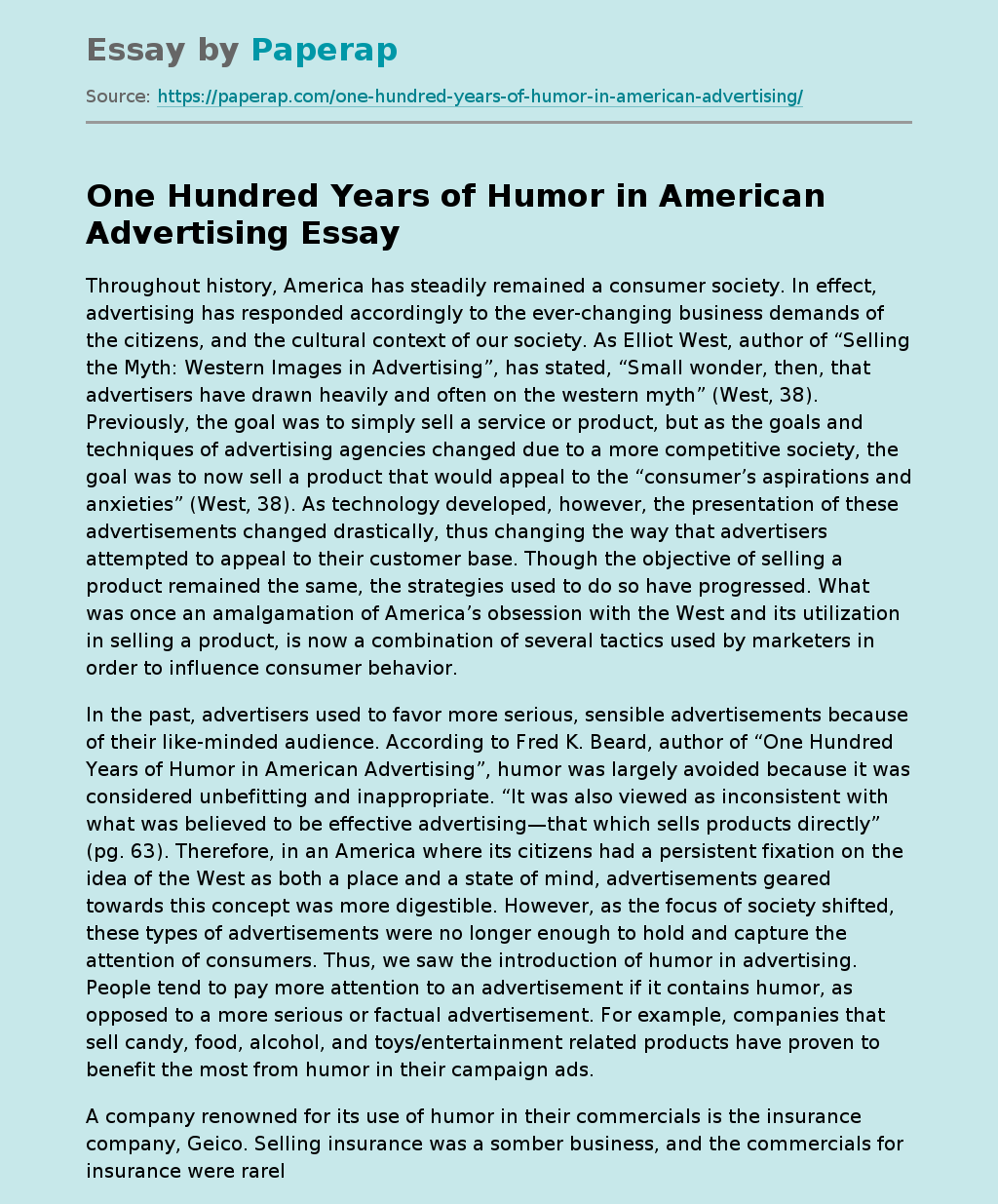One Hundred Years of Humor in American Advertising
Throughout history, America has steadily remained a consumer society. In effect, advertising has responded accordingly to the ever-changing business demands of the citizens, and the cultural context of our society. As Elliot West, author of “Selling the Myth: Western Images in Advertising”, has stated, “Small wonder, then, that advertisers have drawn heavily and often on the western myth” (West, 38). Previously, the goal was to simply sell a service or product, but as the goals and techniques of advertising agencies changed due to a more competitive society, the goal was to now sell a product that would appeal to the “consumer’s aspirations and anxieties” (West, 38).
As technology developed, however, the presentation of these advertisements changed drastically, thus changing the way that advertisers attempted to appeal to their customer base. Though the objective of selling a product remained the same, the strategies used to do so have progressed. What was once an amalgamation of America’s obsession with the West and its utilization in selling a product, is now a combination of several tactics used by marketers in order to influence consumer behavior.
In the past, advertisers used to favor more serious, sensible advertisements because of their like-minded audience. According to Fred K. Beard, author of “One Hundred Years of Humor in American Advertising”, humor was largely avoided because it was considered unbefitting and inappropriate. “It was also viewed as inconsistent with what was believed to be effective advertising—that which sells products directly” (pg. 63). Therefore, in an America where its citizens had a persistent fixation on the idea of the West as both a place and a state of mind, advertisements geared towards this concept was more digestible.
However, as the focus of society shifted, these types of advertisements were no longer enough to hold and capture the attention of consumers. Thus, we saw the introduction of humor in advertising. People tend to pay more attention to an advertisement if it contains humor, as opposed to a more serious or factual advertisement. For example, companies that sell candy, food, alcohol, and toys/entertainment related products have proven to benefit the most from humor in their campaign ads.
A company renowned for its use of humor in their commercials is the insurance company, Geico. Selling insurance was a somber business, and the commercials for insurance were rarely upbeat. Ads featuring natural disasters, or fires, or robberies, served as a clear-cut warning that disaster could strike in a minute. Similarly, insurance companies also used commercials to tell the story of the unanticipated death of parents who were uninsured, leaving their children with a financial burden. Mutual of New York’s 1974 commercial, featuring a young John Travolta, is one such advertisement that comes to mind as a prime example of this tactic. The ad depicts a young Travolta walking down the street, and telling the audience of his father’s promise that his son wouldn’t have to work as hard as he did because of the money he saved for him. The ad turns somber quickly as Travolta proceeds to tell the audience of his father’s passing. He then walks into a luncheonette, and dons an apron and subsequently gets to work. A dejected voice over then reminds the viewers of the effects of remaining uninsured, namely, the effects it has on your family.
However, Geico became a game changer with the use of their newer, more comedic commercials, and other insurance companies followed suit. In order to lighten the burden of having to sell insurance, Geico decided to launch a new campaign, one that included the Geico gecko. It’s reptilian mascot brought lightheartedness into selling insurance. As Joanne Kaufman, author of “It Began With a Gecko. Mayhem (and Flo and Peyton) Ensued”, states, “Since then, Geico’s ad campaigns have featured the cavemen, Maxwell the pig and rhetorical questions like: “Could switching to Geico really save you 15 percent or more on car insurance? Does a 10-pound bag of flour make a really big biscuit?” (Kaufman, The New York Times).
After utilizing humor to sell their service, Geico became the second largest company to sell car insurance in America. A prime example of Geico’s use of humor in their commercials is their “Buckle Up” commercial. The advertisement opens with two cowboys leaning against a corral. The camera cuts from one man to the other constantly, with one cowboy telling the other of how much he receives from Geico. Every time the camera focuses back on him, the size of his belt buckle increases comically, until it is an impractical size. Not only does the commercial serve as a reminder of how effective Geico is as an insurance company, it also looks back on America’s history of the West in their advertisements. However, it is now being done in a satirical, humorous way. The commercial also laughs at the machismo attributed to cowboys in an amusing manner. In this way, Geico promotes their service effectively, in both an earnest yet comical way.
One Hundred Years of Humor in American Advertising. (2021, Dec 14). Retrieved from https://paperap.com/one-hundred-years-of-humor-in-american-advertising/

